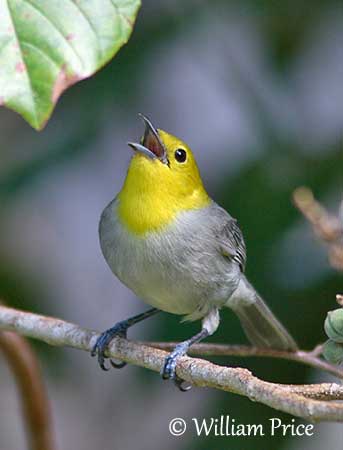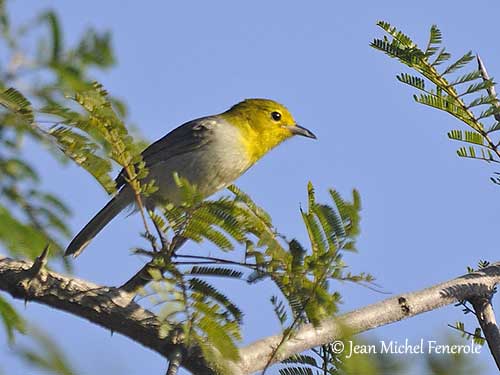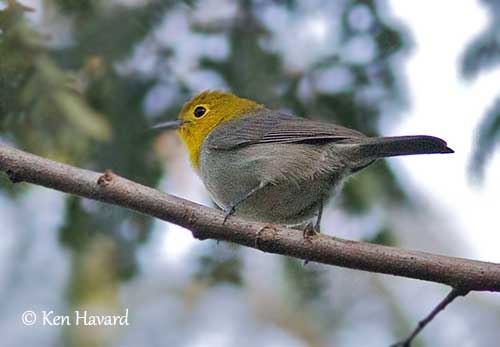Fr: Paruline de Fernandina
Ang: Yellow-headed Warbler
All: Gelbkopf-Waldsänger
Esp: Reinita Chillina
Ita: Parula testagialla
Nd: Geelkopzanger
Sd: gulhuvad kubasångare
Photographers:
Jean Michel Fenerole
Photos d’Oiseaux du monde
Ken Havard
My Bird Gallery & Flickr gallery 1 & Flickr gallery 2
William Price
PBase-tereksandpiper & Flickr William Price
Text by Nicole Bouglouan
Sources:
HANDBOOK OF THE BIRDS OF THE WORLD Vol 15 by Josep del Hoyo-Andrew Elliot-David Christie - Lynx Edicions – ISBN: 9788496553682
BIRDS OF THE WEST INDIES – by Herbert Raffaele, Kristin Williams et Tracy Pedersen – Helm – ISBN: 9780713649055
Neotropical Birds – Cornell Lab of Ornithology
Arthur Grosset's Birds (Arthur Grosset)
Cuba Explorer - Birds of Cuba - Endemic and near endemic birds of Cuba
A new subspecies of Oriente Warbler for Pico Turquino, Cuba, with ecological comments on the genus
By Orlando H. Garrido
Yellow-headed Warbler
Teretistris fernandinae (Family Uncertain)
Passeriformes Order – Parulidae Family
INTRODUCTION:
The Yellow-headed Warbler is endemic to Cuba and Isle of Pines. Like the Oriente Warbler, its placement in the family Parulidae remains uncertain, following evidence from DNA sequence, with three missing molecules of DNA after various analysis. Research work on the New World warblers is still in progress, because these birds are evolving rapidly, with several very closely related genera, making often uncertain the placement of the species in one or another genus.
The Yellow-headed Warbler frequents a variety of forests from sea-level up to mountains, and is sedentary within its restricted range. It is common with stable population.
DESCRIPTION OF THE BIRD:
Biometrics:
Length: 13 cm
Weight: 6-18 g
The Yellow-headed Warbler adult has grey upperparts and paler greyish-white underparts. But it differs from the Oriente Warbler by the conspicuous yellow hood, slightly tinged olive on crown and nape.
The bill is blackish with grey base. It is slightly down-curved, but not as markedly as in T. fornsi. The eyes are dark brown, surrounded by yellow eyering. Legs and feet are bluish-grey.
Male and female are similar, but the juvenile is not described.
RANGE:
The Yellow-headed Warbler is resident in the western part of Cuba, on Isle of Pines and Cayo Cantiles, with no geographical overlap with the other warbler T. fornsi. However, the two species are very close (10km) on the north coast, at the border of the provinces Villa Clara and Matanzas. On the south coast, it occurs in Peninsula de Zapata.
HABITAT:
The Yellow-headed Warbler frequents forest and wooded areas from lowlands to mountains, and it also occurs in scrubby thickets in semi-arid areas.
CALLS AND SONGS: SOUNDS BY XENO-CANTO
The Yellow-headed Warbler utters a shrill, repeated “tsi-tsi-tsi”. But its voice is almost similar to that of T. fornsi. It also gives series of buzzy grating sounds interspersed with softer notes, usually more musical “tsi-tsi-tsi…tzeeet-tzeeet…tsi-tsi-tsi”.

BEHAVIOUR IN THE WILD:
The Yellow-headed Warbler feeds on a variety of insects and other invertebrates, and occasionally small lizards. However, it also consumes some plant material, but it is primarily an insect-eater.
It forages mainly in understorey and on the ground, up to mid-level, by gleaning prey from branches and foliage. They often forage in flocks.
The breeding behaviour of the Yellow-headed Warbler is unknown. They are probably monogamous and defend the territory all year round.
The courtship displays are unknown too, but we can suggest that the conspicuous yellow head is enhanced by some adapted movements and postures.
The Yellow-headed Warbler is sedentary in Cuba and Isle of Pines, and only performs short flights within the restricted range.

REPRODUCTION OF THIS SPECIES:
The breeding season takes place between March and July, with the egg-laying in March-April.
The cup-shaped nest is made with grasses, rootlets and plant fibres. It is often placed in low vegetation where it is well-concealed under bushes and vines.
The female lays 2-3 pale green eggs with lilac and reddish-brown spots at the larger end.
The breeding cycle is probably similar to that of the Oriente Warbler, with an incubation of 8-9 days. The young leave the nest 10-11 days after hatching.
PROTECTION / THREATS / STATUS:
The Yellow-headed Warbler has restricted range in which it is common. The population is stable and this species is currently evaluated as Least Concern.
